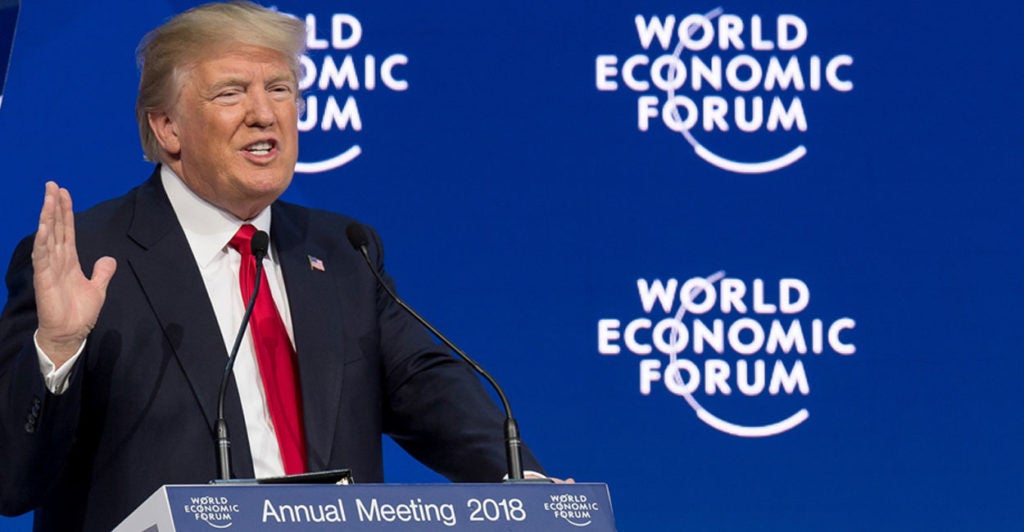“America is open for business.”
In his measured speech to the World Economic Forum, President Donald Trump highlighted his administration’s economic reforms and pointed to the positive trends in economic indicators.
His clear message was: “bring your investment and jobs to the U.S.”
Trump has certainly done much to improve the economy, but he could also do more if he adopted a better message on trade.
But first, let’s review what he’s done right. In addition to tax cuts, the Trump administration has aggressively reigned in rulemaking and eased the regulatory burden, and more is on the reform agenda. Compared to his predecessor, for example, Trump issued one-third fewer new regulations in his first year.
There has been a corresponding change in outlook within the business community, which is also important—businesses now have little fear that a slew of new regulations will undermine investment and business expansion. As a Texas homebuilder told The New York Times, “It’s an overall sense that you’re not going to face any new regulatory fights.”
More freedom is linked to higher income, as shown by research using The Heritage Foundation’s Index of Economic Freedom. Lower taxes, fewer unnecessary regulations, and allowing people to make their own choices unleashes the creativity and commitment that drive economic growth.
The almost daily announcements of new investment, pay increases, and bonuses adds real-world validation to the academic studies. Freedom works.
And that’s exactly why Trump should promote free trade.
An important part of economic freedom is allowing people to define the appropriate market for their products and their suppliers. The best mix of quality, price, innovation, service, and a host of other variables may be next door or it may be on the other side of the world.
Economic prosperity hinges on the freedom to choose between the two.
Increases in shipping efficiency and the dramatic cuts in shipping costs intertwine our economy with the rest of the world—and also make it much stronger. Farms and businesses purchase 60 percent of the goods imported to the U.S. In other words, we use the majority of our imports to increase our own production.
Imagine if you could only buy and sell with those who live in your neighborhood. Most of us would be much poorer indeed. “Protecting” narrow parts of certain industries does overall harm to the economy. These “protections” are taxes that raise costs to consumers (who may be businesses). It is like running the recent tax cuts in reverse. Higher taxes stymie economic activity. There is nothing surprising here.
For instance, the Trump administration’s recent Section 201 tariffs on solar panels and washing machines are likely to follow the pattern set by similar tariffs in the George W. Bush administration. Those tariffs killed 200,000 jobs in the steel-using industries and were undone a year after implementation.
We do not know yet whether the new tariffs will fall short, match, or exceed those job losses. But even the tariffs’ existence could curb interest of internarial businesses from investing in the U.S. Such businesses would almost certainly buy some of their inputs from abroad. The uncertainty over whether the Trump administration might arbitrarily tax critical imported inputs can only dampen investment interest.
An even more insidious problem from the tariffs is the diversion of resources and creativity away from making an industry truly competitive. Instead, tariffs encourage businesses toward seeking ever more special-interest pork and protection.
For struggling industries, trade restrictions are opioids. They make you feel better, but you do not get better.
All of that said, the tariff announcements do not undo all the good that the Trump administration has achieved in one year.
For instance, the Trump administration deserves much credit for pushing economic freedom faster than any previous administration.
Unfortunately, the administration’s trade policies hobble economic growth with higher costs and increased uncertainty.
Of course, stealing intellectual property—one of the reasons given for putting in place tariffs–is bad for us (and the world). We should stop it, but theft is already illegal. In any event, tariffs on steel, aluminum, newsprint, and washing machines do nothing to address the problems of intellectual property theft.
Make no mistake, tariffs are taxes and import restrictions are regulations. They raise costs and disrupt business operations. The Trump administration could add to its already strong record on strengthening the economy by recognizing that freedom to trade is a critical component of economic freedom.
